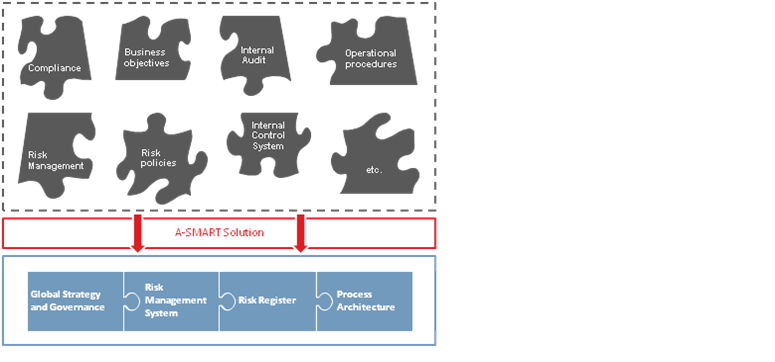Aon Global Risk Consulting – Time to upgrade your Solvency II partner
Our team assists (re)insurance companies, using the risk strategy defined by the Board of Directors, to document and implement Solvency II Directive compliant process
Regarding the 3 Pillars structure, we have developed a wide range of fit-to-purpose services helping insurance and reinsurance companies to achieve a full Solvency II compliance.
Pillar II: Governance and Risk Management System
Proportional solution for small and midsize insurance companies
The Pillar II Context: Governance and Risk Management
Supervisors are paying a lot of attention to Pillar II as it is one of the core principles of Solvency II: insurance undertakings will be forced to put in place processes and controls based on a sound methodology in order to assess, manage and monitor their risks and related solvency requirement. The risk and governance system is the generic denomination of this global process which will help to provide a sound and prudent management of the business and its associated risks. The articles of the Solvency II Directive underlying these requirements are:
- Art. 41: General Governance Requirements
- Art. 42 & 43 : Fit and Proper Requirements
- Art. 44 : Risk Management
- Art. 45 : Own Risk and Solvency Assessment (ORSA)
- Art. 46 : Internal Control
- Art. 47 : Internal Audit
- Art. 48 : Actuarial Function
- Art. 49 : Outsourcing
Key features
- Consistency between the strategy, risk processes and day-to-day operations
- Embedded risk management system
- Sound formalization and documentation
- Clear and efficient reporting channels
- Strong management oversight
- Segregation of duties
- In-depth control environment
Implementing a compliant Governance and Risk Management System: What are the challenges?
The implementation of Solvency II should follow the Principle of Proportionality which states that all requirements must be implemented according to the nature, size and complexity of the undertaking. In addition, a main danger in launching a Pillar II implementation programme is to consider all needs separately and to try to keep multiple projects and sub-projects under control (starting for example, from existing internal control processes or risk management procedures, setting up the ORSA process prior to develop the relevant inputs, etc.).
Missing these points often leads to expensive, never-ending and finally inappropriate implementation projects.
A-SMART Solution
Our proposal to achieve an efficient Pillar II implementation
To assist our customers in the creation of a Solvency II compliant System of Governance, we’ve developed an approach based on four key deliverables addressing all aspects of Pillar II articles:
- Global Strategy & Governance (Article 41)
- Risk Management System (Articles 41, 42, 43, 44, 45, 48, 49)
- Risk Register (Articles 44, 45)
- Process Architecture (Articles 41, 44, 45, 46, 47, 48, 49)
The key objectives underlying our methodology are to:
- Ensure consistency and proportionality
- Avoid overlapping workstreams
- Identify and create missing parts (policies, procedures, etc.)
- Structure the implementation and documentation process
- Reach a full Solvency II compliant operating model including the ORSA process, Internal Control System, Risk Management, Internal Audit, Compliance and Actuarial functions as well as all other compulsory items required by the upcoming regulation
- Facilitate monitoring and updates
